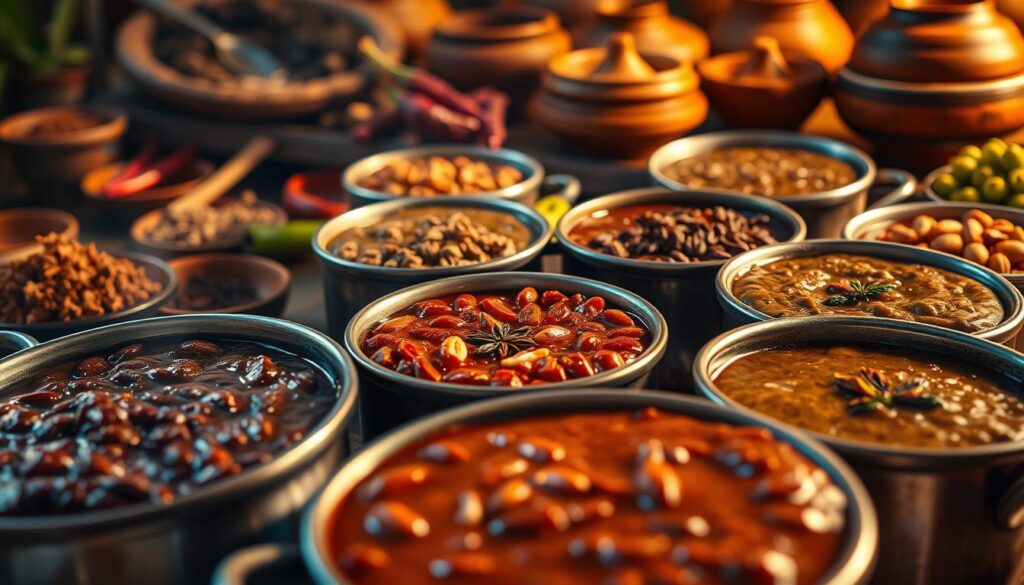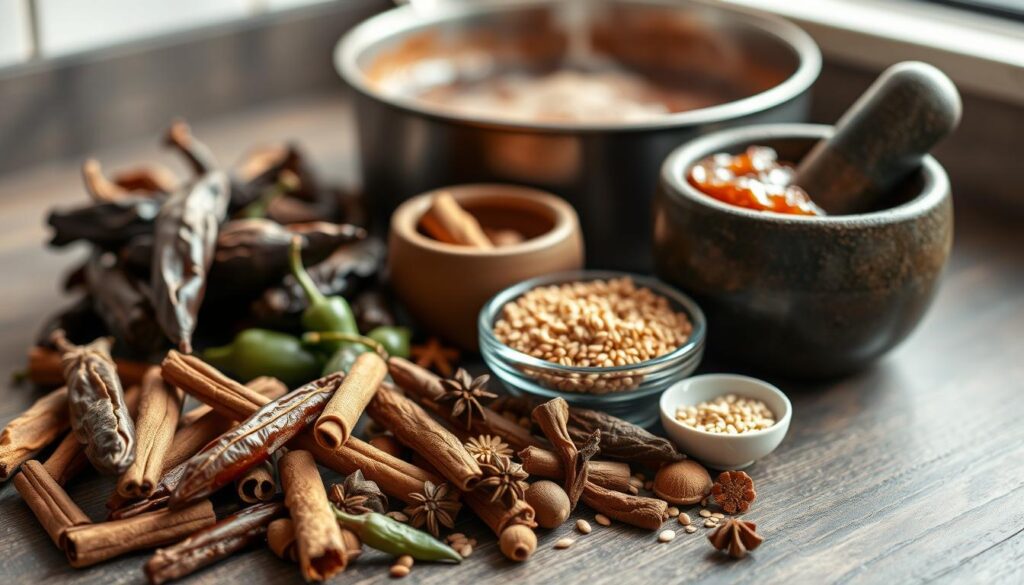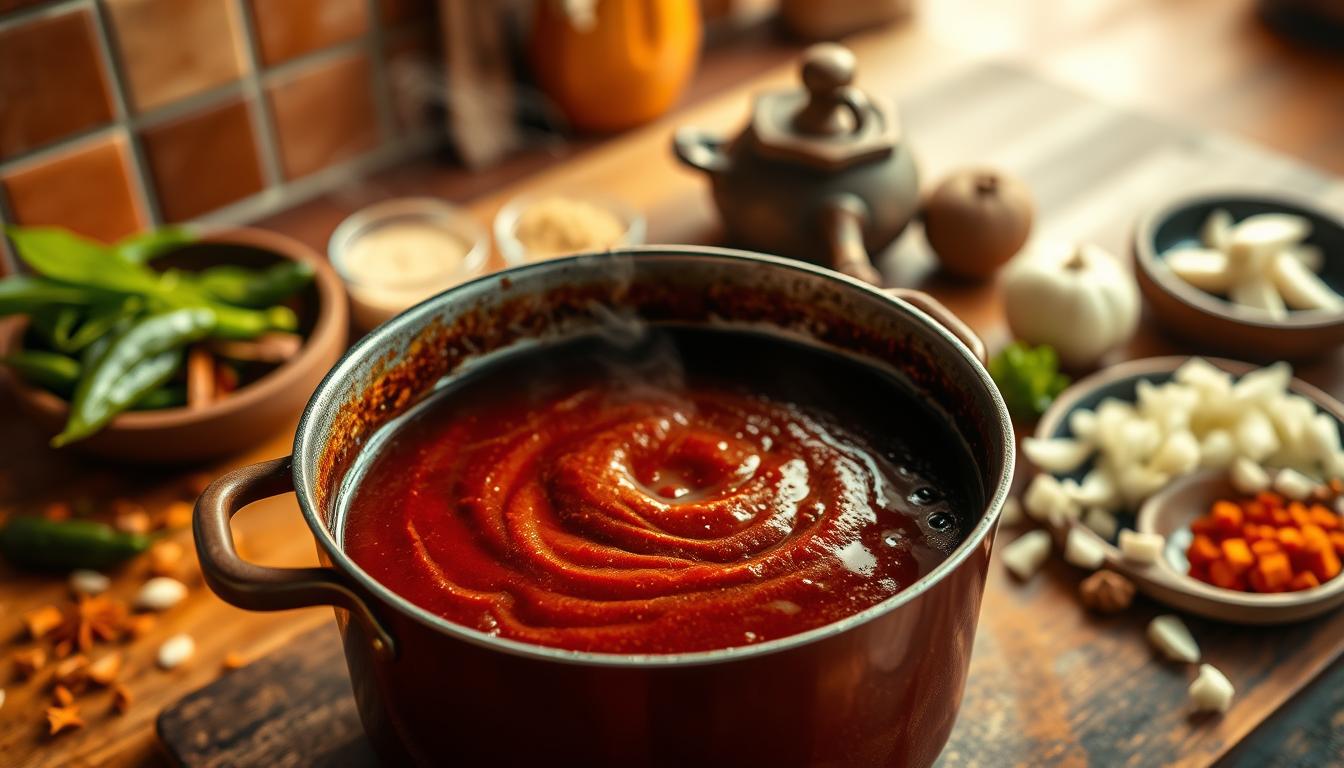Traditional mexican mole recipe You’ll want to make again and again
Table of Contents
Traditional mexican mole recipe You’ll want to make again and again
Imagine savoring a rich, complex sauce that embodies the heart of Mexican cuisine. For centuries, mole has been a cornerstone of traditional cooking, with its intricate blend of flavors and ingredients. The term “mole” originates from the Nahuatl language, meaning “sauce,” and its preparation is an art passed down through generations.
You are about to embark on a culinary journey, making a traditional mexican mole recipe that requires patience and time. With over 20 ingredients, including a hint of chocolate, this recipe yields a deeply flavorful sauce that is both versatile and worth the effort.
Key Takeaways
- Discover the rich history and cultural significance of mole in Mexican cuisine.
- Learn how to make a traditional mole recipe with over 20 ingredients.
- Understand the role of chocolate in balancing the complex flavors of mole.
- Find out how to make a large batch of mole sauce and freeze it for future meals.
- Gain confidence in preparing mole with manageable, step-by-step instructions.
The Rich Heritage of Mexican Mole recipe
Mexican mole is more than just a recipe; it’s a culinary legacy. This complex sauce has been a cornerstone of Mexican cuisine for centuries, with its rich history and diverse ingredients making it a fascinating topic.
What is Mole Poblano?
Mole poblano is a type of mole that originated in the state of Puebla, Mexico. It is characterized by its rich, complex flavor profile, which is achieved by combining a variety of ingredients, including dried chiles, spices, and chocolate.
The ingredients are carefully selected and prepared to create a smooth, velvety sauce that is both savory and slightly sweet. You can experience the depth of this traditional recipe by exploring its preparation process.
The Legend Behind the Dish
The legend of mole poblano’s creation is deeply rooted in Mexican history. According to the story, Sister Andrea de la Asunción created the sauce in 1685 at the Convent of Santa Rosa de Lima.
- The nun’s divine inspiration to create the dish for visiting dignitaries.
- The use of available ingredients to craft a unique sauce.
- The improvisational nature of the recipe, which became a celebrated culinary achievement.
By exploring the heritage of Mexican mole, you gain insight into the country’s culinary traditions and the creativity that defines its cuisine.
Understanding the Complexity of Mexican Mole Recipe
The richness of Mexican mole lies in its complexity, with numerous regional variations that showcase the country’s gastronomic diversity. As you explore the world of mole, you’ll discover that it’s not just a single recipe, but a family of sauces that share certain characteristics while differing in ingredients and preparation methods.
The Unique Flavor Profile
Mexican mole is renowned for its intricate flavor profile, which combines sweet, spicy, and savory notes. The unique blend of ingredients, including chiles, spices, nuts, and chocolate, creates a rich and complex sauce. The flavor profile can vary significantly depending on the type of mole, with some variations being more bitter or acidic.
For instance, the use of certain chiles can add a deep, slightly smoky flavor, while the addition of spices like cinnamon and allspice contributes warmth and depth.
Regional Variations of Mole
Mexico boasts dozens of regional mole recipes, each with its distinct ingredients and preparation methods. Oaxaca is famous for its “seven moles,” including negro (black), rojo (red), coloradito, amarillo (yellow), verde (green), chichilo, and manchamanteles.
- Oaxaca’s moles are known for their complex spice combinations and rich flavors.
- Other regions have their own unique variations, such as the fruit-infused manchamanteles or the herb-forward mole verde.
- Some regional variations don’t use chocolate at all, highlighting the diversity within this sauce category.
You can explore these variations to gain insight into Mexico’s diverse culinary landscape and the importance of local ingredients in traditional cooking.

Essential Ingredients for Authentic Mole Poblano
To create an authentic Mexican mole recipe poblano, it’s essential to understand the ingredients that make up this complex sauce. The richness of mole poblano is attributed to a diverse array of ingredients, including various types of chiles, nuts, seeds, spices, and chocolate.
The Chile Varieties
The foundation of mole poblano lies in its variety of chiles, which provide the sauce with its distinct flavor and heat. Some of the commonly used chile varieties include mulato, pasilla, and ancho chiles. These chiles are typically toasted and then rehydrated to bring out their deep, rich flavors.

Nuts, Seeds, and Spices
In addition to chiles, nuts, seeds, and spices play a crucial role in the flavor profile of mole poblano. Almonds, raisins, and cinnamon are commonly used ingredients that add depth and warmth to the sauce. The combination of these ingredients helps to balance the heat from the chiles, creating a harmonious flavor experience.
As Julia Child once said, “The only time to eat diet food is while you’re waiting for the steak to cook.” In the context of mole poblano, the rich flavors of nuts, seeds, and spices make it a culinary delight worth savoring.
The Role of Chocolate in Mole
One of the most distinctive ingredients in mole poblano is chocolate. Contrary to popular belief, chocolate isn’t the dominant flavor in mole poblano but rather serves as a balancing ingredient that adds richness and helps tame the heat from the chiles. Traditional mole poblano uses Mexican chocolate, which differs from European chocolate by including cinnamon and sometimes almonds already incorporated into the tablet.
- Mexican chocolate contributes subtle bitterness and complexity rather than sweetness, with the cacao helping to round out the sauce’s flavor profile.
- Only a relatively small amount of chocolate is used in proportion to the other ingredients—typically about 2-3 ounces for a large batch of mole.
- When making mole poblano, the chocolate is typically added near the end of cooking, allowing it to melt into the sauce without overwhelming the other flavors.
While some may think that mole is a chocolate sauce, the truth is that not all mole variations contain chocolate, and the amount used is relatively small compared to other ingredients, making it a subtle addition that enhances the overall flavor without adding excessive sugar.
Step-by-Step Preparation of Traditional Mexican Mole recipe
To create a rich and complex mole poblano, you’ll need to follow a series of carefully outlined steps. The process involves several key stages, from preparing the chiles to simmering the final mixture.
Preparing the Chiles
The first step in making mole poblano is preparing the chiles. This involves toasting and rehydrating several types of dried chiles, such as ancho, mulato, and pasilla chiles. Begin by toasting the chiles lightly in a dry pan to enhance their flavor. Then, rehydrate them by soaking them in hot water until they become soft. Once rehydrated, remove the stems and seeds, and chop the chiles into manageable pieces for further processing.
Toasting and Frying the Ingredients
Toasting and frying the ingredients is crucial for developing the deep, complex flavors characteristic of mole poblano. Start by toasting spices, nuts, and seeds in a dry pan until fragrant. Then, fry the chopped chiles and other ingredients in a bit of oil to bring out their flavors. Be cautious not to burn the ingredients, as this can introduce bitterness into the mole.
Blending and Straining Techniques
After toasting and frying the ingredients, the next step is to blend them into a smooth mixture. Use a blender or food processor to combine the ingredients until they form a uniform paste. Then, strain the mixture through a fine-mesh sieve to remove any solids and achieve a silky texture. This step is crucial for ensuring the mole has a smooth, velvety consistency.
Simmering to Perfection
The final and perhaps most crucial step in preparing mole poblano is the extended simmering period. Begin by heating the strained sauce in a heavy-bottomed pot over medium heat until it begins to bubble, then reduce to low heat for the remainder of cooking. This simmering stage typically takes 30 minutes to an hour, during which the sauce must be stirred frequently to prevent sticking and burning on the bottom of the pot. As you cook, the sauce will gradually thicken as moisture evaporates, developing a rich consistency that should coat the back of a spoon. This is when stirring constantly is essential. You may need to add more chicken broth to achieve the desired consistency. Taste and adjust the seasoning by adding salt or sugar as needed to balance the flavors. The mole is ready when it reaches a velvety consistency and the flavors have melded together into a complex, layered mixture.
Tips for Making the Perfect Mole Poblano
Crafting an authentic Mexican mole recipe poblano is an art that requires patience and practice. To achieve the perfect balance of flavors, it’s essential to understand the intricacies of this complex sauce.
Common Mistakes to Avoid
When making mole poblano, there are several common pitfalls to watch out for. One of the most critical mistakes is not toasting the ingredients properly, as this can result in a lack of depth in the flavor profile. Additionally, be careful not to overprocess the mixture, as this can lead to a sauce that’s too thick and unpleasantly textured. To avoid these issues, take your time to carefully toast and blend the ingredients.
Make-Ahead and Storage Options
One of the benefits of making mole poblano is that it can be prepared ahead of time and stored for later use. The recipe yields a concentrated mole paste that can be diluted with stock when you’re ready to serve. To store, portion the cooled mole into freezer-safe containers in 1-cup or 2-cup measurements, labeling with the date and contents. You can store it in an airtight container in the fridge for up to 3-5 days or freeze for up to 6 months. When reheating, warm the mole gently over low heat, adding stock as needed to achieve the desired consistency. Be aware that a thin layer of fat may form on the surface when refrigerated; this is natural and helps preserve the sauce.
By following these tips, you’ll be able to create a rich and complex mole poblano that’s sure to impress. With a little practice and patience, you’ll master the art of making this traditional Mexican sauce.
Serving Your Homemade Mexican Mole recipe
Serving your homemade Mexican mole is where the real creativity begins, with a range of traditional and modern ideas to try. Your mole poblano recipe is versatile and can be paired with various dishes to create a memorable dining experience.
Traditional Pairings
You can make enmoladas (mole enchiladas) with this rich sauce or serve it over potatoes, chayote, and zucchini with rice. Traditional pairings often feature mole poblano served over chicken, but you can also experiment with other proteins.
- Pair your mole with traditional Mexican dishes for an authentic experience.
- Use it as a topping for grilled meats or vegetables.
Modern Serving Suggestions
Contemporary chefs have expanded mole poblano‘s applications beyond traditional chicken, using it as a sophisticated sauce for duck, pork, or even seafood. You can also use it in vegetarian and vegan adaptations, featuring the sauce over roasted vegetables, mushrooms, or plant-based proteins.
- Create enmoladas by dipping corn tortillas in mole sauce, filling them with cheese or chicken, and topping with more sauce.
- Use a quarter cup of mole as a base for plating, arranging sliced protein or vegetables on top, and garnish with sesame seeds and micro herbs.
- Try mole poblano drizzled over fried eggs and crispy potatoes for a modern brunch, garnished with queso fresco and cilantro.
Conclusion
As you savor your homemade mole poblano, remember that you’re experiencing a culinary legacy that has been refined over generations. Creating this authentic Mexican mole recipe from scratch connects you to centuries of tradition, despite the time investment.
The mole recipe offers numerous benefits, including a rich flavor profile and nutritional value. According to the Institute of Medicine, mole sauce is an excellent source of various vitamins and minerals such as Vitamin B, riboflavin, phosphorus, iron, magnesium, calcium, zinc, and niacin, making it a valuable addition to your meals.
With its versatility, you can enjoy your poblano sauce in multiple dishes, from traditional to modern applications. Mastering this recipe not only enhances your cooking skills but also gives you a deeper understanding of Mexican cuisine. The balance of sweet, spicy, and savory elements in a well-made mole poblano creates a unique culinary experience. Whether for a special occasion or exploring Mexican heritage, this mole is sure to impress, with its rich flavor and numerous health benefits, including a touch of sugar that balances the dish.
FAQ
What is the best way to store ancho chiles?
Can I substitute peanuts with almonds in mole poblano?
How do I toast sesame seeds without burning them?
What type of chocolate is best for mole poblano?
Can I make mole poblano ahead of time?
How do I thin out a thick mole sauce?
For more cooking tips, stay connected with us. We also recommend the cookbook Skinnytaste Simple: Easy, Healthy Recipes with 7 Ingredients or Fewer
For more Recipes about Chicken
Did You try our recipe ?
There are no reviews yet. Be the first one to write one.





